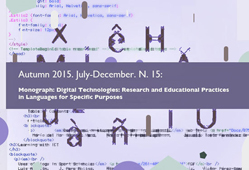La implicatura en los blogs educativos. Una aproximación pragmática.
DOI:
https://doi.org/10.7203/attic.15.5177Palabras clave:
CMC, educational blog, conversational maxim, implicature, pragmatics Resumen
Resumen
La tecnología está multiplicando las formas en que podemos comunicarnos. Desde la aparición de Internet, la construcción del discurso, los géneros discursivos y el lenguaje mismo se han visto afectados por las características de este nuevo modo de comunicarse. Aparecen discursos mixtos que hacen necesarios nuevos enfoques. Así, el estudio de la red desde una perspectiva pragmática ha abarcado diferentes aproximaciones (el género, la caracterización del lenguaje de los textos, etc.); los blogs han sido considerados como una forma de conversación. El presente trabajo estudia los blogs educativos desde el punto de vista de las máximas conversacionales de Grice, y, en particular, las implicaturas, para intentar caracterizar estos intercambios y determinar si, y hasta qué punto se trata de conversaciones y cómo se comportan desde un punto de vista pragmático. Los resultados muestran que los blogs educativos se asemejan más a una clase magistral que a una conversación.
 Citas
Citas
Álvarez Bonilla, Francisco; Bartra Gros, Francisca; López Meneses, Eloy; Sandoval Romero, Yamile (2015). Experiencias universitarias en escenarios virtuales formativos. Cali: Universidad de Santiago de Cali.
Blood, Rebecca (2000). Weblogs: A History and Perspective, Rebecca's Pocket, 07 September 2000. http://www.rebeccablood.net/essays/weblog_history.html
Bolander, Brook (2012). Disagreements and agreements in personal/diary blogs: A closer look at responsiveness. Journal of Pragmatics, 44, pp.1607-1622 http://dx.doi.org/10.1016/j.pragma.2012.03.008
Chu, Samuel K.W.; Chan, Carol K.K.; Tiwari, Agnes F.Y. (2012) Using blogs to support learning during internship. Computers & Education, 58, pp.989–1000. http://dx.doi.org/10.1016/j.compedu.2011.08.027.
Crystal, David (2001). Language and the Internet. Cambridge: Cambridge University Press.
Deng, Liping; Yuen, Allan H.K. (2010). Towards a framework for educational affordances of blogs, Computers & Education, 56, pp.441–451, 2011. http://dx.doi.org/10.1016/j.compedu.2010.09.005.
Ducate, Lara C.; Lomicka, Lara L. (2005). Exploring the blogosphere: use of web logs in the foreign language classroom. Foreign Language Annals, 38(3), pp.410–421. DOI: 10.1111/j.1944-9720.2005.tb02227.x
Efimova, Lilia; Moor, Aldo de. (2005). Beyond personal webpublishing: An exploratory study of conversational blogging practices. Proceedings of the 38th Hawai’i International conference on system sciences. IEEE Press: Los Alamitos, 2005.
Dyrud, Marilyn A.; Worlei, Rebecca B.; Flatley, Marie E. (2005). Blogging for enhanced teaching and learning. Business Communication Quarterly, 68, pp.77–80. http://bcq.sagepub.com/content/68/1/77.refs doi: 10.1177/108056990506800111
Grice, H.Paul (1975). Logic and conversation. En Peter Cole y Jerry L. Morgan (Eds.), Syntax and Semantics, 3: Speech Acts. New York: Academic Press, pp.41-58.
Grice, H.Paul (1989). Studies in the Way of Words. Cambridge: Harvard University Press.
Herring, Susan C. (2007). A faceted classification scheme for computer-mediated discourse. Language@Internet 4 (1). . http://www.languageatinternet.org/articles/2007/761
Herring, Susan C. (2010). Who’s Got the Floor in Computer-Mediated Conversation? Edelsky’s Gender Patterns Revisited. Language@Internet, 7 (8). http://www.languageatinternet.org/articles/2010/2857
Herring, Susan C.; Scheidt, Lois Ann; Bonus, Sabrina; Wright, Elija (2004). Bridging the gap: a genre analysis of Weblogs. Proceedings of the 37th Hawai’i International Conference on System Sciences-2004. (http://dx.doi.org/10.1109/HICSS.2004.1265271).
Horn, Laurence R. (2004). Implicature. En L.R. Horn y G.L. Ward (Eds.), The Handbook of Pragmatics. Oxford: Blackwell, pp.3-28. http://dx.doi.org/10.1002/9780470756959.ch1
Kempson, Ruth (2001). Pragmatics: Language and Communication. En M. Aronoff y J. Rees-Miller, (Eds.).The Handbook of Linguistics. Oxford: Blackwell. http://dx.doi.org/10.1002/9780470756409.ch16.
Kleinke, Sonja (2010). Speaker activity and Grice’s maxims of conversation at the interface of Pragmatics and Cognitive Linguistics. Journal of Pragmatics, 42, pp.3.345–3.366. doi:10.1016/j.pragma.2010.05.008
Jimoyiannis, A.; Angelaina, S. (2012). Towards an analysis framework for investigating students’ engagement and learning in educational blogs. Journal of Computer Assisted Learning, 28(3), pp.222-234. DOI: 10.1111/j.1365-2729.2011.00467.x
Langellier, Kristin M.; Peterson, Eric E. (2004). Storytelling in daily life: Performing narrative. Philadelphia: Temple University Press.
Levinson, Stephen C. (2000). Presumptive Meanings: The Theory of Generalized Conversational Implicature. Cambridge: MIT Press.
Peterson, Eric E (2001).How conversational are weblogs? Language@Internet, 8 (8), 2011. http://www.languageatinternet.org/articles/2011/Peterson
Robertson, Judy (2011). The educational affordances of blogs for self-directed learning. Computers & Education, 57, pp.1.628–1.644. http://dx.doi.org/10.1016/j.compedu.2011.03.003
Sadock, J.M.(1978). On testing for conversational implicature. In Peter Cole (ed.), Syntax and Semantics, 9: Pragmatics. New York: Academic Press, pp.281-297.
Sykes, Julie M. (2005).Synchronous CMC and Pragmatic Development: Effects of Oral and Written Chat. CALICO Journal, 22 (3), pp. 399-431. https://calico.org/html/article_142.pdf
Tusón Valls, Amparo (2002). El análisis de la conversación: Entre la estructura y el sentido. Sociolingüística, 3.1, pp.133-135. http://www.sociolinguistica.uvigo.es/articulosXvolumen.asp?id=10
Yus Ramos, Francisco (2010). Ciberpragmática 2.0. Nuevos usos del lenguaje en Internet. Barcelona: Ariel.
Descargas
Publicado
Número
Sección
Licencia
Todos los artículos de la revista, están sujetos a una licencia Creative Commons del tipo Reconocimiento - NoComercial - Sin Obra Derivada
